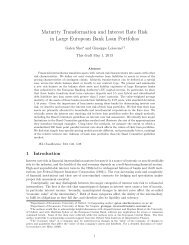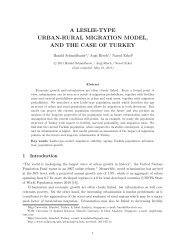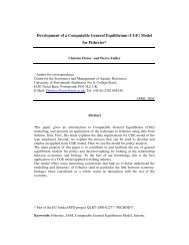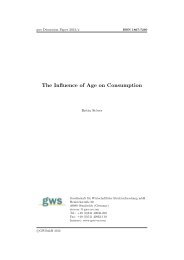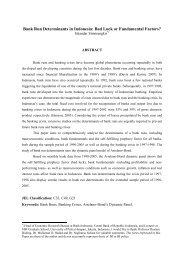substitution for all agricultural products are reduced by 50%. 16M M-low variation relative var.Albania 44 24 -20 -45%Croatia 286 182 -104 -36%Cyprus 60 32 -28 -46%Egypt 697 411 -286 -41%France -1783 -1386 397 -22%Greece 1687 951 -736 -44%Italy 4596 2871 -1.725 -38%Morocco 16787 10140 -6.647 -40%Spa<strong>in</strong> 8169 4838 -3.331 -41%Tunisia -2062 -1179 882 -43%Turkey 2547 1476 -1.071 -42%Rest.Euro 18191 10166 -8.025 -44%Rest MENA 20145 11399 -8.745 -43%RoW -69365 -39925 29.439 -42%Table 6 – Increases <strong>in</strong> VW Imports with reduced elasticities (millions of m 3 )As expected, countries which were import<strong>in</strong>g virtual water now import much less, whereas virtualwater exporters now export less. The last column of Table 6 show relative variations, that is <strong>the</strong>percentage change <strong>in</strong> virtual water imports relative to <strong>the</strong> percentage change <strong>in</strong> substitutionelasticities (here -50%). Results are fairly homogeneous: halv<strong>in</strong>g <strong>the</strong> substitution elasticities impliesreduc<strong>in</strong>g virtual water imports of about 40%.S<strong>in</strong>ce <strong>the</strong> volume of virtual water trade depends on <strong>the</strong> elasticities of substitution, one may wonderwhat determ<strong>in</strong>es <strong>the</strong> value for <strong>the</strong>se parameters, <strong>and</strong> what could make <strong>the</strong>m change. In general,elasticities of substitution tell us how easy <strong>the</strong> substitution process may be for consumers <strong>and</strong> firms.Elasticities will be high (<strong>and</strong> <strong>the</strong> virtual water trade mechanism more effective) when goodsproduced <strong>in</strong> different locations are perceived as similar, <strong>in</strong> <strong>the</strong> sense that <strong>the</strong>y have similar effectson production processes, or on consumer's utility.Reduc<strong>in</strong>g transportation costs or o<strong>the</strong>r barriers to trade would also <strong>in</strong>crease virtual water trade, ofcourse. However, only by <strong>in</strong>creas<strong>in</strong>g elasticities of substitution <strong>in</strong> <strong>the</strong> model we can make <strong>the</strong>economy more reactive (<strong>in</strong> terms of virtual water trade) to exogenous shocks.4. CaveatsIn this paper we presented a procedure for analyz<strong>in</strong>g <strong>the</strong> virtual water trade response to a possiblewater scarcity scenario <strong>in</strong> <strong>the</strong> Mediterranean. Results, however, are affected by uncerta<strong>in</strong>ty <strong>and</strong> anumber of weaknesses. Future research will address some of <strong>the</strong>se po<strong>in</strong>ts.First, at <strong>the</strong> present time, global climate models do not appear to provide reliable, consistent <strong>and</strong>robust estimates at <strong>the</strong> regional level, especially for variables different from temperature, like16 This is simply to test how sensitive <strong>the</strong> results are to different values for <strong>the</strong> elasticities of substitution.12
precipitations. For example, models used <strong>in</strong> this study forecast a strong decrease of wateravailability <strong>in</strong> Morocco <strong>and</strong> some <strong>in</strong>crease <strong>in</strong> Tunisia, whereas different climate model providedifferent scenarios.In this study, we focused on variations <strong>in</strong> <strong>the</strong> Mean Annual Runoff, but a more correct estimate ofwater availability should take <strong>in</strong>to account groundwater <strong>and</strong> non-conventional water supply (e.g.,recycl<strong>in</strong>g, desal<strong>in</strong>ation). Fur<strong>the</strong>rmore, we have not addressed <strong>the</strong> issue of future variations <strong>in</strong> nonagriculturalwater uses. These appears to be problematic, especially for sou<strong>the</strong>rn Mediterraneancountries, where demographic <strong>and</strong> urbanization trends cannot be disregarded.F<strong>in</strong>ally, <strong>in</strong> our simulations we assumed a constant marg<strong>in</strong>al productivity of water, rul<strong>in</strong>g out anysubstitution possibility with o<strong>the</strong>r factors. Actually, variations <strong>in</strong> water availability may have a verydifferentiated impact, depend<strong>in</strong>g on <strong>the</strong> type of crop <strong>and</strong> on specific conditions. A number ofagronomic studies are available, analyz<strong>in</strong>g <strong>the</strong> relationship between volume of irrigated water <strong>and</strong>crop yield, but <strong>the</strong> ma<strong>in</strong> problem <strong>in</strong> this context is adapt<strong>in</strong>g <strong>the</strong>se estimates for models <strong>in</strong> whichheterogeneous agricultural products are considered with<strong>in</strong> <strong>the</strong> same sector, <strong>in</strong>to a broad region <strong>and</strong>at yearly scale.Address<strong>in</strong>g <strong>the</strong> po<strong>in</strong>ts above will not be easy, as it will require a strong <strong>in</strong>terdiscipl<strong>in</strong>ary approach<strong>and</strong> cooperation. On <strong>the</strong> o<strong>the</strong>r h<strong>and</strong>, it is important to underst<strong>and</strong> that <strong>the</strong> work is <strong>in</strong>novative, s<strong>in</strong>cevery few studies have tackled <strong>the</strong> issue of macroeconomic <strong>and</strong> systemwide consequences of waterscarcity. Most studies consider, as a geographical unit, <strong>the</strong> hydrological bas<strong>in</strong>, typically assum<strong>in</strong>g asgiven climate conditions <strong>and</strong> a number of socio-economic factors, like water dem<strong>and</strong>. To get an<strong>in</strong>tegrated assessment of water resources management, different models with different scales needto be <strong>in</strong>terfaced, for example by us<strong>in</strong>g <strong>the</strong> hydrological bas<strong>in</strong> (even across countries) as a unit toallocate water flows, match<strong>in</strong>g <strong>the</strong>m with adm<strong>in</strong>istrative boundaries.5. Conclud<strong>in</strong>g remarks<strong>Virtual</strong> water trade is noth<strong>in</strong>g new. Any time <strong>the</strong>re is trade <strong>in</strong> goods, whose production <strong>in</strong>volvessome consumption of water, we can say <strong>the</strong>re is a virtual water exchange. What is <strong>in</strong>terest<strong>in</strong>g to seeis how effective is this, autonomous, market driven adjustment mechanism <strong>in</strong> curb<strong>in</strong>g <strong>the</strong> negativeimpact of water scarcity, particularly <strong>in</strong> relation to climate change.Climate change is expected to alter <strong>the</strong> precipitations pattern, <strong>and</strong> consequently <strong>the</strong> availability ofsurface <strong>and</strong> ground water. <strong>Water</strong> availability will <strong>in</strong>crease <strong>in</strong> some countries, which are oftenalready water abundant, whereas it will decrease <strong>in</strong> some o<strong>the</strong>r regions, most notably <strong>in</strong> <strong>the</strong>Mediterranean. <strong>Water</strong> scarcity translates <strong>in</strong>to higher prices for water <strong>in</strong>tensive goods <strong>and</strong> services,<strong>the</strong>reby reduc<strong>in</strong>g exports <strong>and</strong> <strong>in</strong>creas<strong>in</strong>g imports, which can be <strong>in</strong>terpreted as implicit net imports ofwater.This paper is, to our knowledge, <strong>the</strong> first one <strong>in</strong> <strong>the</strong> literature on virtual water trade to assessscenarios of future water availability by means of CGE simulations. Our results suggest that <strong>the</strong>virtual water mechanism can help <strong>in</strong> reduc<strong>in</strong>g <strong>the</strong> impact of water scarcity, but it can only do thatmarg<strong>in</strong>ally. In o<strong>the</strong>r words, virtual water trade alone cannot solve <strong>the</strong> problem. Public policies are<strong>the</strong>refore needed to adjust <strong>the</strong> exist<strong>in</strong>g <strong>in</strong>frastructure <strong>and</strong> to better manage water dem<strong>and</strong>.The effectiveness of virtual water trade is related to <strong>the</strong> degree of flexibility with<strong>in</strong> <strong>the</strong> regionaleconomic systems. More flexible production processes, more globalization <strong>and</strong> <strong>in</strong>tegration, lower13




